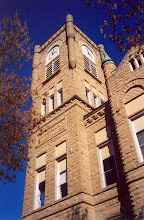Mallory Landmarks: First National Bank
Smith H. Mallory purchased controlling interest the Chariton banking house of Lyman Cook & Co. during 1870 with partners Edward Ames Temple and Joseph Braden and renamed it First National Bank.
Mallory built it into one of southern Iowa’s largest and most secure banks and moved it during 1882 into the banking rooms of the new Union Block at the northwest corner of the square.
It became the financial center of his universe and after his 1903 death, doomed his legacy.Trusted associate and bank cashier Frank R. Crocker siphoned its funds to cover investment losses and after his 1907 suicide, the bank came crashing down. In the aftermath, the Mallory heirs gave up all their holdings in Lucas County to help cover its losses.
This is the text of the third in a series of five Mallory interpretive panels prepared by Frank D. Myers for The Freight House, restored by the Chariton Arts Council as a public venue and interpretive center for Chariton's railroading heritage.
Mallory built it into one of southern Iowa’s largest and most secure banks and moved it during 1882 into the banking rooms of the new Union Block at the northwest corner of the square.
It became the financial center of his universe and after his 1903 death, doomed his legacy.Trusted associate and bank cashier Frank R. Crocker siphoned its funds to cover investment losses and after his 1907 suicide, the bank came crashing down. In the aftermath, the Mallory heirs gave up all their holdings in Lucas County to help cover its losses.
This is the text of the third in a series of five Mallory interpretive panels prepared by Frank D. Myers for The Freight House, restored by the Chariton Arts Council as a public venue and interpretive center for Chariton's railroading heritage.


0 Comments:
Post a Comment
<< Home